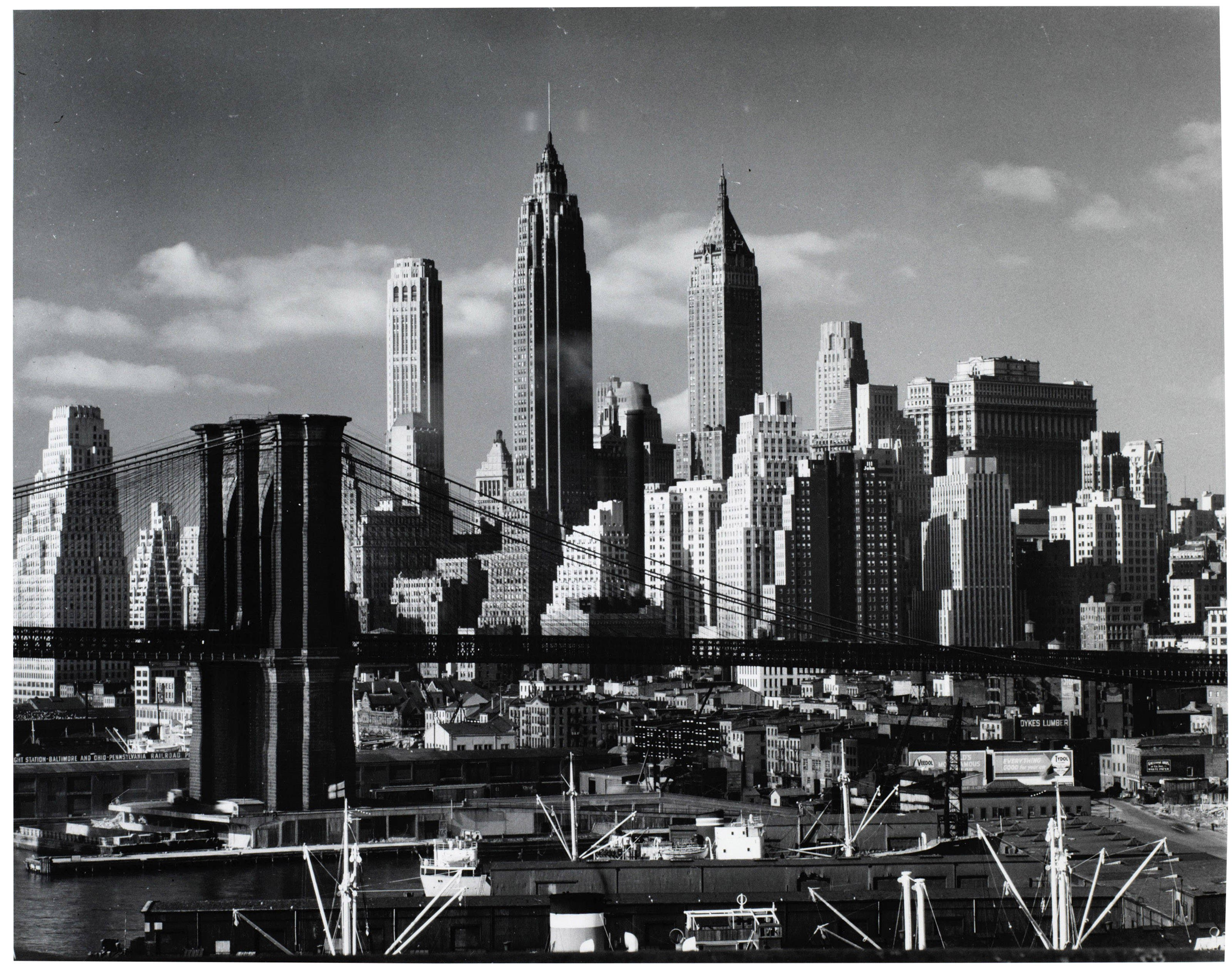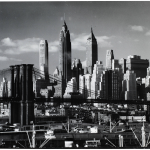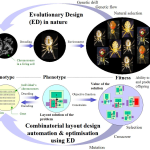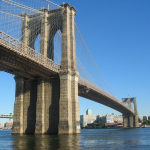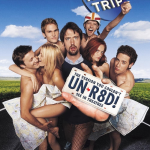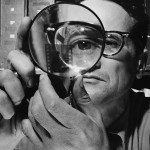Andreas Feininger photography stands as a remarkable testament to the vibrancy of New York City during its postwar Golden Age, an era when the metropolis emerged as a pivotal cultural hub. Born in Paris and educated in Germany, Feininger blended his Bauhaus architectural training with a keen eye for detail, producing images that encapsulated the essence of urban life in the 1940s and 1950s. His captivating shots of the city’s iconic skyline, gritty waterfronts, and intricate traffic patterns not only reflect the physical landscape but also convey the spirit of the New Yorkers who inhabited it. As a renowned LIFE magazine photographer, Feininger established himself as a master urban portraitist, capturing the interplay of form and scale without the distraction of human presence. Through his lens, he immortalized postwar New York’s architectural wonders, offering future generations a glimpse into the complexities of this bustling capital of the world.
The photography of Andreas Feininger is synonymous with the transitional period of postwar New York, a city that evolved into a symbol of modernity and resilience. An influential figure in the realm of urban photography, Feininger’s works reflect his intricate understanding of composition, derived from his roots in Bauhaus art principles. His unique ability to blend architectural elements with the hustle and bustle of city life has earned him recognition as a pivotal figure among LIFE magazine photographers. Whether depicting the robust skyline or the subtleties of the metropolitan landscape, Feininger’s artistry captures the dynamic essence of urban living, making him a celebrated chronicler of this notable historical era. By intertwining the natural and manmade, his photography resonates with contemporary audiences, showcasing a narrative of New York that remains timeless.
The Legacy of Andreas Feininger in New York City Photography
Andreas Feininger stands as a monumental figure in the realm of New York City photography, especially during its postwar Golden Age. His work captures not just the physical structure of the city, but the very spirit of urban life in a transformative era. Born into a rich artistic environment, Feininger’s background in architecture and Bauhaus principles allowed him to see New York’s landscape not merely as a backdrop, but as a living entity with its own character and aesthetic. This unique viewpoint enabled him to create images that resonate with the pulse of the city during a time when it was establishing itself as a global capital, echoing the ambitions and dreams of countless inhabitants who called it home.
Feininger’s photographic style, characterized by geometric forms, sweeping lines, and an emphasis on light and shadow, was instrumental in defining the narrative of postwar New York. He often portrayed the city as a vast, vibrant canvas, a bustling stage where each structure played a crucial role in the urban performance. This ability to blend the mundane with the monumental made his work not only visually arresting but also deeply reflective of the societal changes occurring at that time. Through his lens, we not only witness the physical attributes of famous landmarks but also the emotions and stories they encompassed.
Bauhaus Influence in Feininger’s Urban Portraits
The principles of Bauhaus heavily influenced Andreas Feininger’s aesthetic, shaping his approach to urban portraiture and photography. This foundational design philosophy emphasized function, simplicity, and the importance of materials, which Feininger skillfully integrated into his artistic practice. His images often strip away excess, focusing instead on essential forms that define the urban environment of New York City. The rhythmic patterns of the city’s architecture, the stark contrasts presented by shadows, and the clarity of spatial perceptions reveal a disciplined eye trained in the rigorous environment of Bauhaus.
Feininger’s iconic photographs showcase New York through a lens of orderly chaos, highlighting both human innovation and the artistry embedded in everyday life. By adopting a Bauhaus-inspired approach, he became an unparalleled urban portraitist who could convey the essence of New York without relying heavily on human subjects. Instead, he captured the interplay between architectural grandeur and the dynamic energy of the city, presenting images that felt both timeless and refreshingly modern. This innovative perspective allowed him to delve into the city’s soul, making his work highly relevant to both the photographic world and urban studies.
A LIFE Behind the Lens: Feininger’s Work with LIFE Magazine
Andreas Feininger’s tenure at LIFE magazine from 1943 until 1962 significantly shaped his career and contributions to photography. As one of the prominent photographers at LIFE, Feininger was not confined to a singular theme; instead, he tackled a diverse range of subjects, from urban landscapes to natural wonders. This dynamic scope allowed him to develop a unique voice within the magazine, blending photojournalism with an artistic sensibility that drew on his architectural background. His ability to capture the essence of his subjects while adhering to the aesthetic values he cherished made his work stand out amid the changing tides of postwar media.
Feininger’s assignments at LIFE often led him to create images that balanced artistic composition with compelling narratives. His profound understanding of light, form, and context resulted in striking photographs that transcended mere documentation, elevating them into art. Through over 340 assignments, Feininger not only chronicled significant historical moments but also left an indelible mark on American culture through his lenses. This versatility enriched the storytelling of LIFE magazine, ensuring that the vibrant life of New York and beyond was captured for future generations.
Exploring the Natural World Through Feininger’s Eyes
In addition to capturing the urban landscapes of New York City, Andreas Feininger harbored a profound fascination with the natural world. His photographic endeavors often led him to explore nature’s beauty and complexity, a passion that stemmed from his childhood in Germany. Feininger possessed a remarkable ability to find stunning compositions in the most unexpected subjects, from animal skeletons to the intricate details of landscapes. His approach to capturing nature was imbued with a similar rigor to his urban photography, emphasizing essential forms and rich textures that conveyed a deeper understanding of the world around us.
Feininger’s 1956 portrayal of Niagara Falls exemplifies this relationship with nature. The photograph captures two silhouetted figures against the majestic backdrop, conveying both scale and the timeless existence of nature. This creates a poignant reminder of humanity’s place within the broader ecological panorama. By blending his architectural sensibilities with natural subjects, Feininger created images that rectified the boundaries between man-made and natural worlds, illustrating an artistic vision that continues to inspire both photographers and nature enthusiasts alike.
The Iconic 1955 Photograph of Dennis Stock
One of Andreas Feininger’s most celebrated images, his 1955 photograph of fellow photographer Dennis Stock, epitomizes his unique approach to urban portraiture. In this work, Feininger employs a stark and striking composition where the camera, rather than the subject’s face, dominates the frame. This intentional choice reflects Feininger’s fascination with the medium of photography itself—highlighting how the tools of the trade can shape the narratives we tell. The mechanical lines of the camera seamlessly integrate into the sleek composition, showcasing Feininger’s architectural background and his commitment to form and function.
This iconic photograph is not just a portrait; it serves as a testament to Feininger’s belief in the relationship between the photographer and their subject. By de-emphasizing the human element, he invites viewers to engage with the photograph on a different level, pondering the intricacies of the craft and the city that shaped both men. This image, much like the city of New York itself, encapsulates a richer story, engaging the audience’s imagination and inviting them to explore the intersection of humanity and machinery in the world of urban photography.
The Allure of Route 66: A Symbol of American Dreams
Andreas Feininger’s photograph of Route 66, taken in 1947, resonates as an iconic symbol of the American journey and the pursuit of dreams. This image captures not just a roadway, but the very essence of freedom and exploration during a transformative period in American history. The composition brilliantly juxtaposes man-made structures against sweeping landscapes, reflecting the ongoing dialogue between nature and urban development that defines much of the American experience. Feininger’s adeptness at finding beauty in the mundane imbues this photograph with an air of nostalgia, evoking a longing for adventure and the open road.
This exploration of Route 66 encapsulates the spirit of postwar America, a time when countless citizens ventured out in search of opportunity and a new life. Feininger’s work serves as both a snapshot of a moment and an enduring testament to the myths surrounding the American dream. The allure of the open road is immortalized through his lens, continuing to inspire future generations to discover the vast landscapes of both the natural and the constructed world. As such, Feininger’s photographs carry a timeless quality that resonates with those who yearn for connection and adventure.
Celebrating Feininger’s Diverse Exhibitions and Publications
Throughout his illustrious career, Andreas Feininger published over 30 books and exhibited his work in prominent galleries worldwide. His autobiography, ‘Andreas Feininger: Photographer,’ stands as a recognized classic, offering insights into his life, artistic philosophy, and the evolution of his technical approach to photography. Many of these publications featured stunning collections of his striking images, showcasing the breadth of his work—from urban scapes of postwar New York to the intimacy of nature. This vast body of work has solidified his legacy as a significant figure in photographic history.
Exhibitions featuring Feininger’s photographs have been presented in a variety of respected venues, including MoMA and the International Center of Photography. These exhibitions celebrated his unique perspective and mastery of photography, while also fostering an appreciation for the stories behind each captured moment. With retrospectives touring Europe in later years, Feininger’s influence continues to be discovered and celebrated by new audiences, affirming his important role in shaping our understanding of urban life and natural beauty through the lens of postwar American photography.
The Lasting Impact of Feininger’s Photography on Urban Studies
The evocative quality of Andreas Feininger’s photography has made a notable impact on the field of urban studies. His images capture the essence of New York City in a way that echoes the complexities of urban life. By focusing on architectural and landscape elements, he created a visual narrative that invites viewers to ponder the relationship between the city and its inhabitants. Feininger’s ability to convey scale, structure, and movement allows for a deeper interpretation of the city as not just a backdrop, but as a living entity shaped by the people who dwell within it.
Scholars and urban enthusiasts often reference Feininger’s work when exploring the evolution of American cities and the social narratives that emerge from them. His photographs serve as both historical documents and artistic interpretations, bridging the gap between art, architecture, and the lived experience of urban living. The distinct vision he presented through his lens continues to inspire contemporary discussions about urban development, identity, and the inherent beauty found in the interweaving of humanity and architecture in bustling environments like New York City.
Frequently Asked Questions
How did Andreas Feininger’s photography capture the essence of New York City during the postwar era?
Andreas Feininger’s photography is a remarkable representation of New York City during its postwar Golden Age. His images showcase the architectural grandeur and urban landscapes of the city in the 1940s and ’50s, reflecting its vibrant energy and complexity. With a focus on form and scale, he portrayed iconic structures and the bustling streets, creating a visual narrative of how the city perceived itself during this transformative period.
What themes are prevalent in Andreas Feininger’s New York City photography?
The prevalent themes in Andreas Feininger’s New York City photography include the interplay of architecture and urban life. Influenced by his Bauhaus background, Feininger’s work prioritizes simplicity, form, and structure. His images often emphasize the city’s dramatic skyline and landmark bridges while sometimes abstracting the human element, highlighting the city as an expansive, intricate landscape.
What techniques did Andreas Feininger use as a master urban portraitist?
As a master urban portraitist, Andreas Feininger employed various techniques to capture the spirit of New York City and its inhabitants. He often utilized stark contrasts, unique angles, and compositions that emphasized line and pattern, inspired by his Bauhaus training. This approach allowed him to encapsulate both the essence of urban life and the grandeur of the architecture, making his portraits compelling and visually impactful.
In what ways did Feininger’s work for LIFE magazine influence his photography style?
Feininger’s extensive work for LIFE magazine greatly influenced his photography style by allowing him to explore a diverse range of subjects beyond urban landscapes. His assignments compelled him to adopt a narrative approach, capturing moments that combined aesthetic beauty with poignant storytelling. This versatility enriched his overall style, incorporating elements from fashion, natural history, and everyday life into his iconic photographic oeuvre.
What are some notable exhibitions featuring Andreas Feininger’s photographic work?
Andreas Feininger’s photographic work has been featured in numerous prestigious exhibitions, including those at MoMA, the Metropolitan Museum, and the International Center of Photography. His photographs have been showcased in solo and group exhibitions worldwide, including a retrospective tour in the late 1990s that highlighted his favorite black-and-white photographs spanning six decades, from 1928 to 1988.
How has Andreas Feininger’s photography impacted the perception of postwar New York City?
Andreas Feininger’s photography has significantly impacted the perception of postwar New York City by capturing the city’s transformation into a global capital. His images illustrate not just the architectural grandeur but also the urban environment’s complexity and dynamism. By focusing on the city’s interplay with its inhabitants and their surroundings, Feininger’s work has become a visual testament to the era’s cultural and societal shifts.
What distinguishes Andreas Feininger as a Bauhaus photographer?
Andreas Feininger is distinguished as a Bauhaus photographer through his innovative approach to composition and his focus on form and simplicity. His training in the Bauhaus movement shaped his aesthetic, encouraging him to create images that are not only visually appealing but also deeply conceptual. This philosophy is evident in his photographs of New York City, where he masterfully blended architectural elements with an artistic vision that transcends mere documentation.
| Key Points |
|---|
| Andreas Feininger is recognized as a key photographer of New York City during its postwar Golden Age, capturing the city as a global capital. |
| Born in Paris and raised in Germany, Feininger was trained as a cabinet-maker and architect in the Bauhaus style. |
| His photography in the 1940s and 50s illustrated New York’s identity through its architecture rather than its inhabitants. |
| Feininger’s work was characterized by an appreciation for simplicity, form, and pattern in both architecture and art. |
| While he worked for LIFE magazine, Feininger completed over 340 assignments across various subjects, expanding his photographic range. |
| He also captured natural subjects, showcasing their beauty and solemnity, like animal skeletons and landscapes. |
| Feininger authored more than 30 books, with notable exhibitions at major institutions like MoMa and the Smithsonian. |
| He left behind a legacy as a master urban portraitist and passed away in February 1999 at the age of 92 in Manhattan. |
Summary
Andreas Feininger photography stands as a profound testament to New York City during its transformative postwar years. His ability to encapsulate the essence of the city through its architectural marvels speaks volumes about his artistic vision. By prioritizing structure and pattern over the busy lives within, Feininger crafted visual narratives that not only reflected New York’s grandeur but also its soul. With a career spanning decades and an influence that resonates in contemporary photography, Feininger’s work remains crucial for understanding urban visual culture and the rich history of New York.
